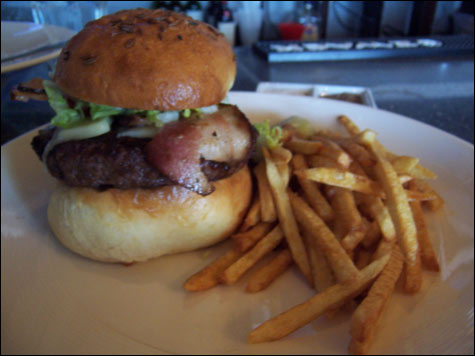
AMID THE FEAST Don’t miss the fantastic burger. |
Those French know how to cook. But here in America, French cuisine too often comes with a demi-glace of pedantry and a side of self-congratulation. The new East Ender in Portland offers a chance to experience French technique in a humbler mode.
The new spot is next to Duckfat in the little gourmet ghetto that has grown up on the corner of Middle and India streets — in the space that used to be Norm's. It has more culinary ambition than the pub it replaces, and in that way is a better fit with the surrounding businesses. The East Ender's neighbor, Ribollita, us a nire casual place made dressier with white tablecloths and candles, and has the prices to match, with entrees around $15. The East Ender feels more like a formal place dressing down. French ingredients and technique are channeled into a somewhat New Englandy menu, and served in a mostly casual space — with the price of entrées landing around $20.
A transition from high-French to New England casual requires taking things down about three notches (from pedantic, to pretentious, to refined). It's like fitting a finicky Citroën engine into a comfy Buick. While the resulting deceleration can be slightly jarring, the East Ender mostly keeps things pretty smooth — especially downstairs, where they have done some work to polish the place up with a thick coat of gray-blue paint on the walls, tables whose wood might have been salvaged from a bowling alley, and some brightly colored hipster-art. The royal blue napkins perched on the light maple tables gives things a vaguely seaside feel. There is a nice bar, with yellow stools that like to roll backward on their fat wheels. The upstairs still looks a good bit like the old Norm's, and out of sync with the menu.
For a good sense of the hybrid they are shooting for, you can start with a salad of iceberg lettuce and Thousand Island dressing, with croutons made from calf's brain. The salad evokes memories of childhood, but breaking through the crisp exterior of the crouton to the creamy meat below stimulates a different part of the brain entirely. Attractive little trout fritters offer more bread than flesh, and recall hush-puppies. You dip them in a thick caper-aioli that is much like a refined tartar sauce.
A plate of cured meats ranged from a fatty-sweet mortadella that reminds of childhood bologna, to a dense, chewy sopressata, to a more refined duck confit. A honey-drizzled pork belly was too sweet, but the liver-mousse was just sweet enough. A soup made with cream and escarole was rich with the flavor (as well as crunchy with the texture) of slightly bitter leaves and herbs.
The entrées get a little Frenchier, and mostly to good effect. The duck breast had a rich, gamey flavor that the chef wisely let speak for itself. It sat on a honey polenta that had too much sugar, and was served with halved Brussels sprouts that might have used a touch more roasting and less boiling. The Parisian gnocchi, made without potato, had a light, pillowy quality. The edges disintegrate like the dumpling is ready to melt away. They sat in a creamy sauce made with plenty of pecorino, and spotted with crunchy celery hearts and snap peas.